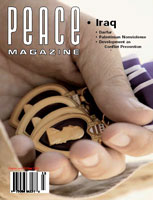
Peace Magazine Oct-Dec 2004, page 5. Some rights reserved.
Search for other articles by various here
The article "From Peacekeeping to 'Peace Operations'" was very encouraging. I have been eager to learn about what was actually being taught at the Pearson Peacekeeping Centre in Cornwallis and afraid to ask lest it be more peace enforcing mechanisms at the end of a gun. Civil society needs civil institutions to function fairly and effectively and so needs people educated in the provision of those institutions should be added to those of engineers, agronomists and police.
Many years ago Mary Wynne Ashford and then Science for Peace wrote about the need for a peace force. It was suggested that a corps of people trained and equipped to respond immediately to natural and man-made disasters should be formed as are fire departments. Such a corps would need to be multi-lingual, and equipped with emergency housing, small bulldozers, food and medical supplies, etc. But the personnel, along with engineers and doctors, should include people trained and experienced in the area of civil administration. The chaos ensuing from disasters adds to the trauma that local residents suffer. The quick establishment of the centres where people could find out what is going on, where they can obtain supplies, where they should go for safety, etc. would reduce the chaos and so make recovery easier.
Jean Smith, Toronto
Veterans Against Nuclear Arms (VANA) has embarked on a campaign to inform Canadians of a threat which is rarely talked about. US and Russian nuclear-armed missiles have remained on "Launch-on-Warning" readiness, without interruption, since the 1970s.
According to the Federation of American Scientists, the combined explosive power of these weapons, ready to fire right now, is approximately 2,900 megatons (2,900,000,000 tons). The single warhead which destroyed Hiroshima was 12,000 tons.
Even one-quarter of this destructive power (725 megatons) could potentially destroy the world's major cities, massively pollute the world with radioactive fallout, destroy world supplies and distribution of food, water, fuels and power, resulting in starvation, epidemics and social chaos.
The threshold for Nuclear Winter may be as low as a 100 megaton exchange, resulting in a tropical freezeup and world-wide crop failure.
The danger of accidental missile launch is real and ongoing. "Early warning and command systems are inherently susceptible to technical malfunctions; serious false alarms of incoming nuclear strikes have occurred on both sides. The danger of an accidental missile launch is real and ongoing." (Bruce Blair, Center for Defense Information, Washington, DC.)
The future of the human race is too important a matter to be decided in a few minutes by military officers in the US or Russia. According to Dr. Alan Phillips, a Canadian physician and expert in radiation illness, writing in the Bulletin of the Atomic Scientists: "Removing these missiles from launch-on-warning is the single most urgent task now facing the human race."
We urge readers of Peace Magazine to join the campaign for No Launch-on-Warning. Help us convince the Canadian Parliament and government to persuade Russia and the USA to end their launch-on-warning posture and to take all their strategic nuclear armed missiles off hair trigger alert status.
Murray Thomson
VANA, Ottawa Branch
mothom@cyberus.ca
The Fellowship of Reconciliation condemns the taking of hostages in a school in Beslan, Russia, and mourns the unspeakable tragedy that followed. With its principles of nonviolence, FOR believes that killing for political ends is always wrong....Not only is political violence immoral, but it is also the least likely method to gain sympathy for a cause and the least likely to achieve enduring success.
By resorting to terror, militants who have legitimate grievances undermine the claim they might otherwise have to the moral high ground. They discredit their cause in the international community. When violent countermeasures are taken against them, those measures seem justified to many.
Political violence rarely succeeds in bringing about long-term peace. It almost never accomplishes its goal of permanently cowing the opposition into submission. Nonviolent methods, on the other hand, helped liberate a significant part of the world (India, South Africa, Communist Eastern Europe, Brazil and Chile) and remain the symbol of struggles such as the civil rights movement.
FOR is also disheartened by the response of governments. If violence by militants doesn't accomplish results, nor does retaliatory violence by states provide solutions.
Richard Deats
SCIENCE FOR PEACE
The publication of the papers in this section is subsidized by Science for Peace, an organization dedicated to research and education for peace in the broadest sense. All those who share its objectives are invited to join. Address: Rm A-306, University College, University of Toronto, Toronto, Ont. M5S 3H7. Tel/fax/416/978-3606. E-mail: sfp@physics.utoronto.ca or visit our website at scienceforpeace.sa.utoronto.ca.

Peace Magazine Oct-Dec 2004, page 5. Some rights reserved.
Search for other articles by various here